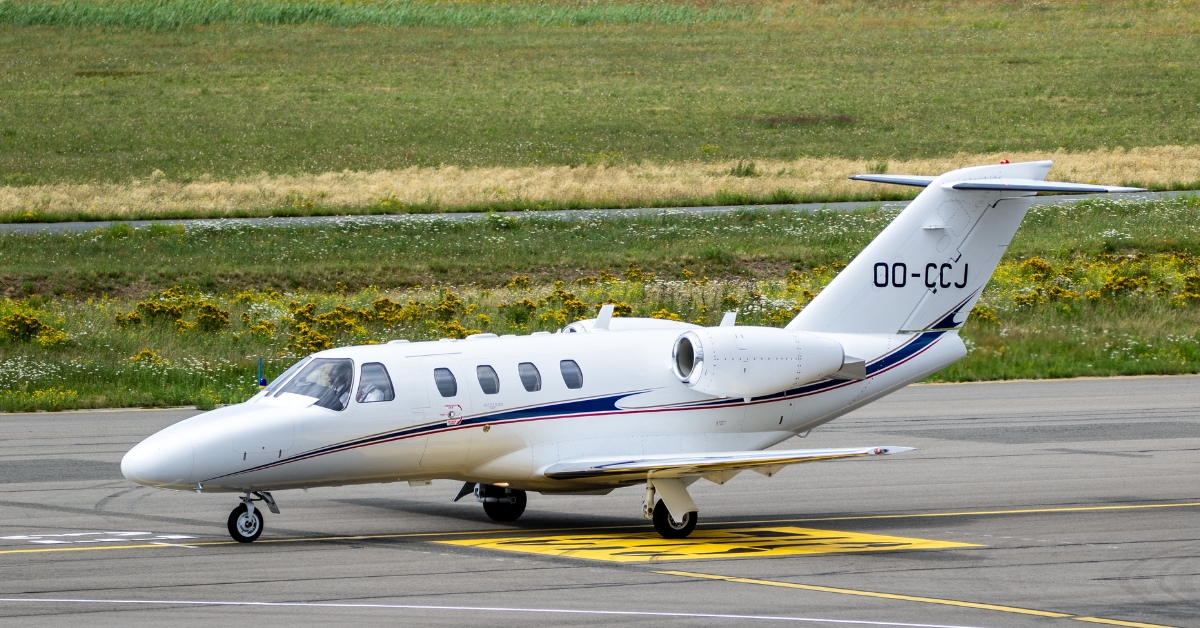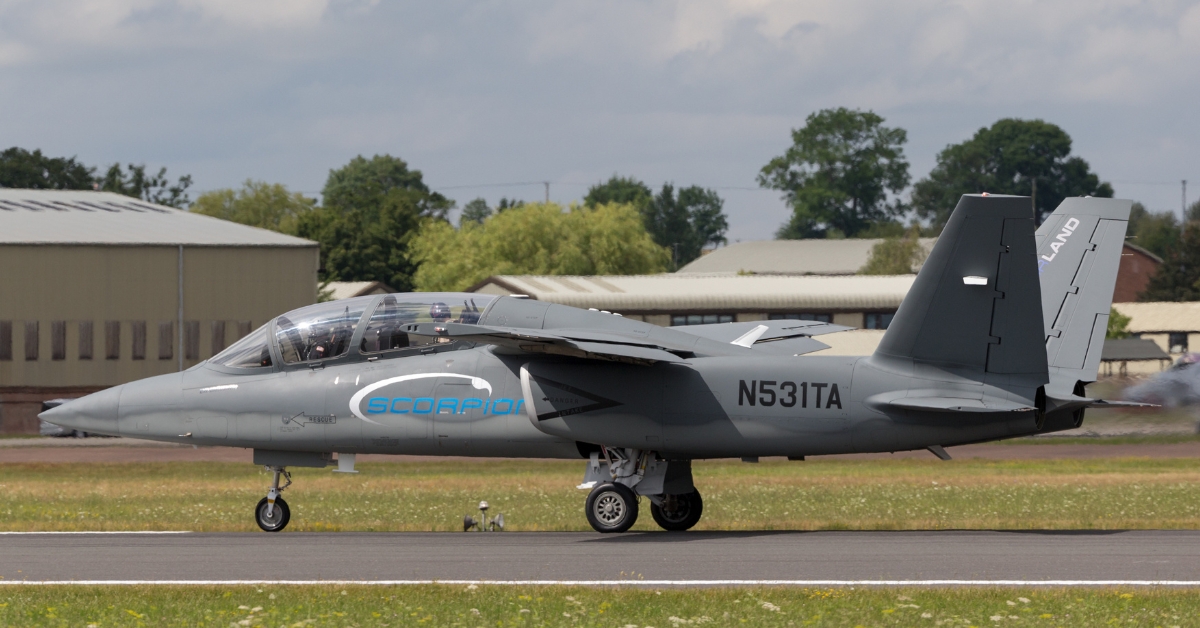This article may contain affiliate links where we earn a commission from qualifying purchases.
Key Takeaways
- Founded by Clyde Cessna and Victor Roos, the company was originally known as the Cessna Roos Aircraft Company
- Today, it’s a wholly owned subsidiary of Textron and is officially known as the Cessna Aircraft Company
- Cessna is an aircraft manufacturer famed for producing single engine piston aircraft models like the Cessna 150 and Cessna 172
- Despite this, Cessna does produce other aircraft, namely its line of Citation Business Jets
- Both today and in the past, Cessna has worked on jet aircraft for the military, namely the Scorpion (currently in development) and the T-37 Tweet (now retired)
Cessna are famous for their single engine pistons, which are among the world’s most popular aircraft. But what about jets? Do they make them as well?
Yes, Cessna does make jets. Their most famous jet aircraft is their Citation family of business jets. In addition, the company has previously made jet trainers for the US and other militaries, and is currently studying another similar concept for the 21st century.
Based on my experience as a pilot who loves to fly everything Cessna, I’m perfectly qualified to answer all your questions about the venerable Cessna Aircraft Company and its various jet aircraft
Who Is Cessna?
Since its 1927 inception, Cessna has been responsible for designing, producing, and delivering over 193,500 airplanes worldwide. America fell in love with Cessna's aircraft during the early 1950s private flying boom.
Cessna is an American general aviation brand aircraft owned by Textron Aviation since 2014. Its headquarters are in Wichita, Kansas. Before being bought by Textron Aviation, the company was a well-known manufacturer of general aviation aircraft. The Cessna brand remains among the world's most renowned aircraft brands.
Options include piston aircraft that lead in recreation and pilot training, flexible and rugged turboprops with remarkable payloads, and an elegant fleet of Citation jet products with uncompromising reliability, comfort, and style with impressive mission solutions.
They are used in specialized missions such as ambulances, surveillance, or flight inspection.
The customizable options allow Cessna customers a broad range of configurations, designs, and solutions. With the line of classic piston aircraft, Caravan turboprops, and Citation jets, Cessna dominates the airways.
The company's broad spectrum of aircraft solutions accounts for over half of all general aviation flights.
Does Cessna Make Jets?
While Cessna concentrates on its well-known single-engined piston aircraft, Citation jets are a growing part of the company's aircraft stable. Cessna started manufacturing jets in 1972. More than 7500 Citations have been built.
Rather than individual types, the Cessna Citation Jet series has several distinct aircraft families. Here is a list of Citation jets.
Cessna T-37 Tweet
This model was designated Model 318. For decades, it was an economical twin-engined jet trainer that flew as the leading trainer for the USAF and several other nations' air forces. Two variants were the T-37C and A-37 Dragonfly, capable of light attack.
The A-37 Dragonfly was used during the Vietnam War. Several South American countries' air forces continue to use it. The T-37 was the primary training vehicle for over 50 years after the initial flight. There were 1269 Cessna T-37s manufactured. The last USAF T-37 was retired in 2009.
Cessna 441 Conquest II

The Cessna 441 Conquest II was the first aircraft designed by Cessna that was turboprop powered (turboprops are essentially jet engines with a propeller attached when it all boils down).
It was meant to fill the gap between piston-engined aircraft and their jets. The Cessna 441 Conquest II was developed in November of 1974 and delivered in 1977.
From 1977 to 1986, Cessna built 362 units. In May of 2019, 290 remained in service.
Cessna Citation Family
Cessna 500 and 501 Citation, Citation I and Citation I/SP
The Cessna 500 Citation and 501 Citation were the foundation of the family. Cessna was the first among the three manufacturers in America to develop jet-powered transport. In October of 1968, the Fanjet 500 was announced.
It flew for the first time on September 15, 1969. In September of 1976, it was upgraded as the Citation I, and in 1977 as a single-pilot variant, 501 Citation I. There were 689 of the variants built before production ended in 1985.
Cessna Citation II

The Citation II is a light corporate jet. In September of 1976, the Model 550 was announced. It flew for the first time on January 31, 1977. The single-pilot II/SP version flew first on February 14, 1984.
A stretched S/II Citation Bravo with more powerful turbofans and new avionics flew for the first time on April 25, 1995. The U.S. Navy adopted a S/II version. Production stopped after 1184 were delivered in 2006.
Cessna Citation III/VI/VII

The Citation III's maiden flight was in 1979. Citation VI was cheaper to make and was manufactured from 1991-1995. A more powerful Citation VII was available from 1992-2000. There were 360 of these combined variants delivered.
The Citation IV was a proposed transcontinental variant canceled before a prototype was made.
Cessna Citation V

The Cessna Citation V is a business jet. A prototype made its first flight in August of 1987. There were 744 delivered until 2011. Upgrades include the Citation Ultra, announced in 1993, and the Citation Encore and Encore+, announced in 1983
Cessna CitationJet/CJ/M2

Known as Model 525, this series of light business aircraft were launched in October of 1989. The first flight was on April 29, 1991. The development of the CitationJet was brought about in response to the Citation I discontinuation in 1985.
Cessna felt there was still a significant market for a light four or five-passenger jet with the ability to operate from a short runway, docile flying qualities, and low operating costs. A slower cruise speed stigmatized the aircraft than the competition. Model 525 serial numbers range from 0001-0359.
CitationJet C1 has serial numbers ranging from 0360-0599. It has an improved Pro Line 21 avionics package. Serial numbers 0600 and higher are referred to as CitationJet CJ1+. The models marketed as Citation M2 have improved turbofans that offer ten to 15 percent more hot-and-high thrust.
Cessna Citation X

Model 750 made its first flight in 1993. An updated Citation X+ had upgraded systems and a 14-inch cabin stretch. It was available in 2014. Production ended in 2018 after 338 deliveries.
Cessna 526 CitationJet

Cessna responded to a request for a trainer jet to be used by the U.S. Air Force and Navy. The 526 shared 75 percent of the 525 characteristics, including the landing gear, engines, and wings. Cessna did not get the government contract. Only two prototypes were built.
Cessna Citation Mustang

The Cessna Citation Mustang is a light jet launched in 2002 at the NBAA Convention and flew for the first time on April 25, 2005. It received FAA certification on September 8, 2006, and was allowed to fly into 'known icing conditions' in November of the same year.
Cessna Citation CJ3 and CJ3+

There are several CJ3 models. Initially certified in 2004, the Citation CJ3 extended earlier models. It offered increased performance and other changes. The single-pilot cockpit could accommodate two crew members if necessary.
There is space for six or more passengers. Between 2004 and 2014, the jet was upgraded to the CJ3+. It had identical interior configuration, operating cost, and performance with different flight instrumentation.
There were 500 CJ3 and CJ3+ aircraft delivered between late 2004 and the spring of 2018. Production of the CJ3 has ended. The CJ3+ is still manufactured.
Citation CJ4

The Cessna Citation CJ4 was announced in 2006 and formally began operations in 2010. It is Cessna's largest aircraft certified under Part 23 standards. The jet is among the latest evolutions of the 500 Citation I.
It seats as many as nine passengers and one or two pilots. The avionics exceed the predecessors with a cockpit fitted with a MultiScan radar system that enhances situational awareness and a Collins Pro Line 21 package.
A comfortable layout makes long flights more enjoyable. It has a refreshment area between the flight deck and door with room for water bottles, cups, ice, coffee, snacks, and disposal facilities.
Citation Excel/XLS/XLS+

The Excel Model 560XL is a medium-sized turbofan-powered business jet. It was announced in October of 1994 at the annual NBBA convention. The prototype's maiden flight was on February 29, 1996.
By April of 1998, Cessna had more than 200 orders for the aircraft. Production ended in 2004, with 308 aircraft delivered. The Citation XLS was the first aircraft developed from the Citation Excel.
It began production in 2003. Its interior features a couch, fold-out tables, indirect LED lighting, and seats nine passengers. Production ended in 2008, with 330 delivered. Of the 330, 329 are still in operation.
After the success of Citation Excel and XLS, Cessna created the XLS+, with several significant performance improvements. It is a mid-sized jet that became available in 2008. The updated design features an extended nose contour to improve aerodynamics.
It also has four-screen LCD EFIS displays and Collins Pro Line 21 glass-panel avionics. The Citation XLS+ is still in production.
Cessna Citation Sovereign

Model 680 made its first flight in February of 2002. It had larger wings and was more powerful. An improved Sovereign+ added winglets and improved engines, and a flight deck. Its maiden flight was in 2013. There were 349 Sovereign and 94 Sovereign+ built.
Citation Latitude

Textron Aviation began building the Citation Latitude in 2005. It is still in production. The Citation Latitude is a large jet with a cabin that is 21.9 feet long, 5.5 feet wide, and six feet tall. It has a seating capacity of 126 passengers.
The baggage compartment holds 18 bags of average size. It can travel at 506 miles per hour. Technical upgrades are the main improvements.
The Latitude offers wireless connectivity that allows passengers to control many comforts, such as connecting to the internet or listening to music from a touchpad. It is among the most technologically savvy jets in the world.
Cessna Citation Columbus
Model 850 was launched in February of 2008 and canceled in July of 2009. It would have been the Cessna family's largest model at the time.
Citation Longitude
The Citation Longitude was launched in 2012. It is a Cessna flagship product. On April 23, 2019, it secured U.S. Federal Aviation Administration-type certification. The prototype flew on October 6, 2016.
There were five prototypes by February of 2018. Together, they accumulated 2000 hours over 1000 flights. Netjets fleet operator ordered 175 Citation Longitude aircraft in October of 2018. The first was delivered in October of the following year.
A spacious, double-club configured cabin has touch-controlled lighting, temperature controls, and window blinds. Passengers can fly long distances, like New York or London, without stopping to refuel.
A unique feature of the Citation Longitude is the fly-by-wire control of the spoilers and rudder that saves weight and allows finer control of ground spoilers, bank, and yaw.
Cessna Citation Hemisphere
Another suspended Cessna jet was the Citation Hemisphere. It was expected to fly in 2019. In April of 2018, it was suspended because of a Safran Silvercrest engine development delay.
Textron AirLand Scorpion

This is an American jet aircraft for light attack, reconnaissance, surveillance, and intelligence. It is a joint effort between AirLand Enterprises and Textron. Between April 2012 and September 2013, a prototype was constructed secretly at Cessna's Wichita, Kansas, facility. Textron has had only one potential customer for the jet.
Does Cessna Make Commercial Jets?
Over the last few decades, commercial airlines transitioned from four to a two-engine standard. Airline economics are closely tied to maintenance costs and fuel efficiency, along with Extended-range Twin-engine Operational Performance Standards (ETOPS),
It seems that the next step would be moving toward single-jet-engine commercial aircraft. Several military and general aviation aircraft have done so. However, it is unlikely there will be a commercial single-jet engine in the near future for Cessna.
Over the past two decades, companies have worked on supersonic commercial aircraft. The research is being conducted in the hope of building a commercial jet by 2050. If it was possible to create a 100-passenger supersonic jet in the 1960s, why can't one be built now?
There are several reasons. They include market demand, fuel economy, and sonic boom. Of the three, market demand is the primary reason. If there is not enough interest in buying the aircraft, companies cannot recover the research and development costs or make a profit.
Short-term-profit orientation and risk aversion make building airliners or business jets that are primarily improvements over previous models safer. Aircraft manufacturers cite the complexity of FAA certification and the cost of manufacture as the reasons for low innovation and high retail prices.
Without demand and increased sales volume, the unit price of aircraft continues to rise. There are other reasons for companies choosing to travel by business jets rather than commercial jets.
A company CEO prefers to drive to a tarmac for immediate boarding instead of spending valuable time at an airport gate. Private jets are invaluable when prompt staff, resources, and supplies transport is necessary.
Data has shown travelers spend hours longer on business trips when they fly commercial. Factors that impact the time spent on commercial jet flights include clearing security, checking bags, boarding delays, cancellations, and rental car duties.
Private jets provide a secure and collaborative work environment. A study by the National Business Aviation Association in 2009 indicated executives are productive 80 percent of the time when they travel by private jet versus 30 percent when they travel on commercial flights.
The number of airports that provide commercial jet flights is much less than those that do not. Business jets make reducing the time between remote cities and airports, rerouting flight paths, and making nonstop flights easier. Business jets fly into areas other airlines do not serve.














